Should Parents Buy Their Kids’ Shoes a 1/2 or Full Size Bigger?
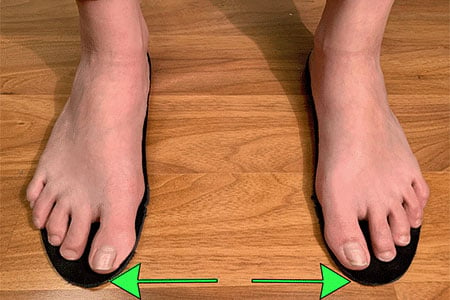
I notice that there is a lot of confusion among parents when it comes to deciding how much room they should provide for their kids’ shoes. Some parents buy their children the size that fits them, while some others buy the shoes on the bigger side so their children can wear them longer.
It’s normal for a lot of families to be tempted to provide their children with some extra growing room as children’s feet tend to grow so fast. I will show you exactly how much growing room is considered acceptable and how much growing room might create foot issues.
I have been fitting children’s shoes for the last 10 years, and while most parents focus on the brand name or material that the shoes are made, the most important thing to keep your kids’ feet healthy is that you don’t provide your child with shoes that are too small or too big. Children’s feet are constantly developing, and what happens to their feet during their childhood will affect their physique as they grow older.
Should Parents Buy their Kids’ Shoes a 1/2 or Full Size Bigger?
I suggest that parents provide their children with shoes that are a half a size bigger than their kids’ foot size, to be more precise, there should be 3/16 of an inch or 0.4 centimeters of space between your child’s longest toe and the end of the shoes.
This amount of space will allow for the correct amount of growing room while preventing the child’s longest toe from rubbing against the front part of the shoes. Take a look at the images below for better visualization purposes:

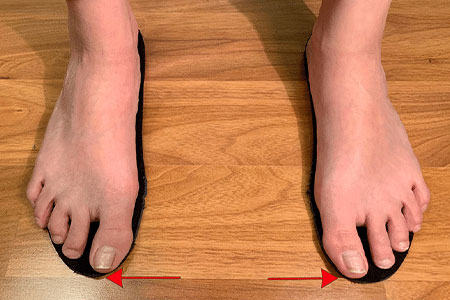
Keep in mind that the amount of space I recommend is from your child’s longest toe and the end of the shoes. In most cases, the child’s longest toe is the big toe. However, there are children who might have their second or middle toe as their longest toe.
In the image below the child’s longest toe is not the big toe, is the second toe:
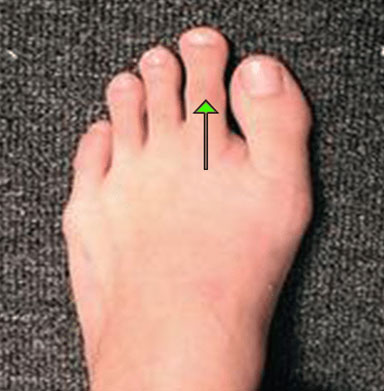
We all have a foot that is bigger than the other, so always check both feet before buying your kids’ shoes.
Whether You Should Buy the Shoes 1/2 or a Full Size Bigger Depends on the Shoe!
Did you know that the final shoe size that you should provide for your child depends on how that particular shoe style fits? Shoes can fit short, long, or true to size, and depending on how they fit, you will have to adjust the final shoe size that you provide for your child. Even among the same shoe brand, certain styles fit differently.
There is no mandatory industry standard for shoe sizing, so each brand will vary. Even though a lot of shoe brands try to have some level of standardization with their sizing, sizing and fit differs from shoe to shoe. Don’t buy your kids’ shoes based on customer reviews, as it’s not clear whether that person who bought the shoes knew his/her child’s exact foot size to begin with.
When in doubt, I suggest getting your kids’ shoes on the longer side, as there are things you can do to make the shoes fit better.
The Shoes that I Like Are Not Available in Half Sizes!
You will notice that some shoe styles are not available in half sizes, they are available in whole sizes only. In this case, it’s highly likely that you will have to order the size up. However, this will also depend on how that specific shoe style fits (short, long, true to size).
Do You Usually Check for a Thumbs Width of Space?
A lot of families like to use this technique to check if their children have the correct amount of space between their lowest toe and the end of the shoes. Keep in mind that sometimes when you use this technique the child might retract their toes, making it seem like there is space when in fact, there is not.
Find Out How to Order the Correct Shoe Size for your Child’s Feet
I suggest that you take your child to be properly fitted for shoes at your local shoe store, where a shoe fitter can properly measure your child’s feet and recommend shoes based on your child’s foot length and shape.
If you live in an area without a store specializing in proper fit, please refer to my article explaining how to measure your kids’ feet from home.
Don’t Buy Your Kids’ Shoes Too Big!
Buying shoes that are too big assuming that your child will grow into them and they will “last longer,” might leave your child vulnerable to trips and falls that could lead to injury. Shoes that are too big can also create foot issues such as blisters, as too much foot movement inside of the shoes will create constant friction between your child’s feet and the shoes.
Don’t Buy Your Kids’ Shoes Too Small!
In my experience, your child will be better off wearing shoes that are on the bigger side rather than the smaller side. Shoes that are too small can lead to blisters, calluses, and ingrown toenails!
Do Toddlers Require Extra Growing Room Inside their Shoes?
Toddlers between the ages of 1 to 3 should have their shoes replaced every 3 ½ to 4 months. Your toddler’s feet will grow ½ size to a whole size every 4 months.
I don’t suggest leaving extra growing room for your toddler as this is a case that your toddler might still be learning how to balance. Most toddlers’ feet grow really fast, and there is nothing we can do about this.
Let Me Know Your Thoughts!
Did you know that a recent study shows that almost two-thirds of children are walking around in shoes that are the wrong size? The study showed that most children were walking around in shoes that were too small.
Children’s feet grow at different rates so don’t be alarmed if your kids’ feet are not growing as fast as you expected.
By the way, if your child is dealing with a foot condition and has enough issues with walking as it is, then please make sure that you fit the shoes correctly. Do not hesitate to contact me if you are having a hard time figuring out what shoe size your child should wear or if you can’t find a specific shoe style for your child:
Do you usually buy your child’s shoes a 1/2 or a full size bigger? Let me know in the comment section below so other families can relate to your experiences.

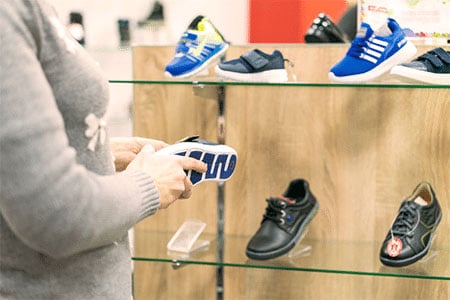
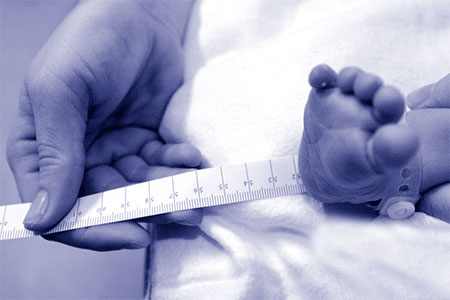
My daughter in law continuously buys her almost 3 yr old shoes that are too big, like up to 2 sizes too big, she trips, she falls & I am concerned about her “clenching” her toes down to keep them on. I personally took to get a properly fitted shoe that I keep at my house so she can run & play freely. I want to tell my sweet daughter in law that this is really important.. without making her mad. As Mother in laws can do, when advice is given. How can I diplomatically bring the subject up? I’ve tried, I’ve failed. Both making her upset & resenting me for it.
Hello Susan,
I think the strongest point you can make is that shoes that are too long can compromise the child’s stability, making the child more prone to falling down. When there is too much extra space inside the shoes the feet also tend to move too much inside the shoes, and that constant friction between the feet and the shoes can lead to foot issues such as blisters.